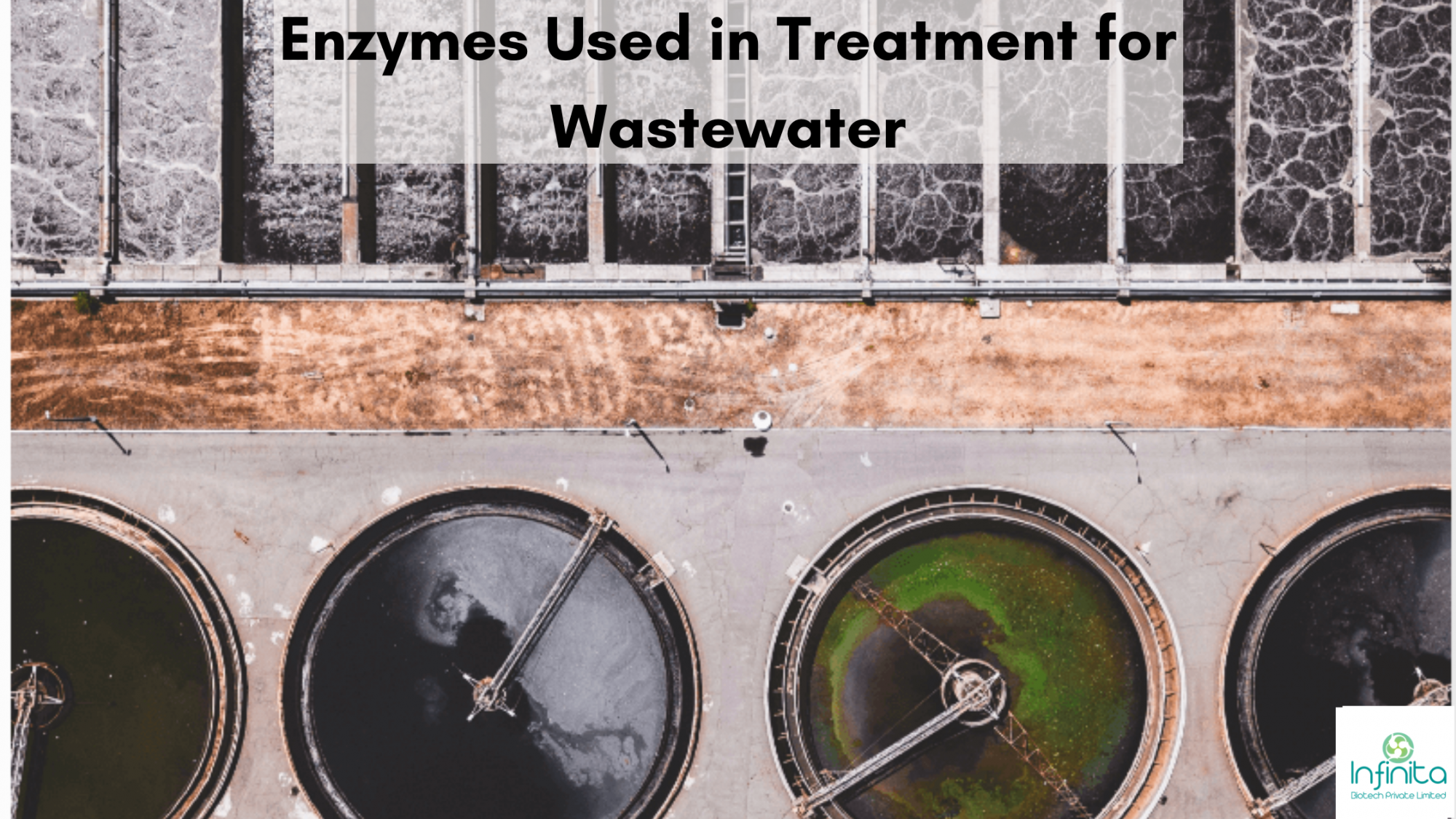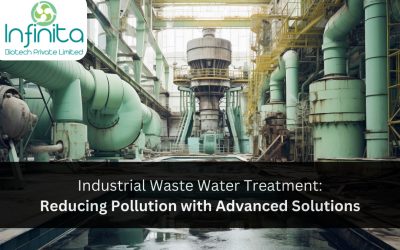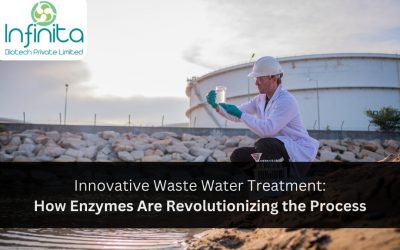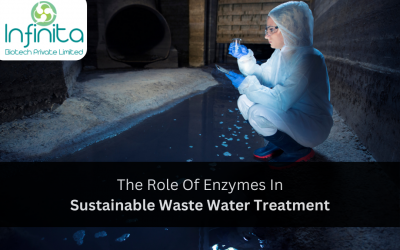
Enzymes Used in Treatment for Wastewater
Water like air is one of the necessities for humans and other living organisms alike. Without water, we cannot function. It is even projected that the third world war may be fought over water resources. Our water reservoirs including rivers, perennial or seasonal rivers and lakes and ponds alike have been heavily contaminated, be they be with industrial pollutants, sewage water, medical toxic waste, tanneries, and waste dumped indiscriminately among several others. Our apathy towards this contamination is mind-blowing.
However, many technologies, whether chemical or physical have been developed to tackle the issue of wastewater treatment. These technologies include chemical treatments like flocculation, coagulation, and adsorption through activated carbon. Some other treatments include nanofiltration, ion exchange process, reverse osmosis, advance oxidation, and photolysis have been developed but these are costly and cannot be undertaken on a large scale, and have been confined to treating water privately for drinking purposes.
But there have been significant developments in biological methods like using enzymes for the wastewater treatment process. These have considerably less cost, are simple to use, and can be used on a wide scale. Moreover, they can completely neutralize impurities and toxic wastes by oxidizing them. The enzyme oxidoreductase which is used as a catalyst in oxidation and reduction reactions, commands special attention as it has broad substrate specificity, enantioselectivity, and regioselectivity which in laymen’s terms means that it can react with a variety of substances with the ability to bonding and breaking in all directions. This is very useful as these traits help in treating chemical pollutants like phenols, dyes, and other compounds.
Oxidative enzymes are different from other chemical oxidants because they do not mineralize the substrate particles but form free radicals which in turn attach to other particles through oxidative reactions to form different compounds having higher molecular weight. These compounds and products thus formed are minimally toxic and more biodegradable than the toxic original compounds i.e., pollutants, thus performing the wastewater treatment process through biological oxidation.
Among oxidative enzymes peroxidases, oxygenases, and polyphenol oxidases like tyrosinases and laccases are generally used for wastewater treatment, which through their oxidation processes cause the decomposition of the inorganic pollutants including phenolic and aromatic chemical contaminants.
Let us look into these enzymes and their workings, one by one.
A. Oxygenases
Oxygenases are intracellular enzymes that help in biosynthesis and metabolism. Oxygenases are able to introduce molecular or atomic oxygen into a variety of pollutants through their property of stereoselectivity, regioselectivity, and enantioselectivity. This introduction of oxygen in their structure converts these hydrophobic compounds into water-soluble compounds. These enzymes are also used in the pharmaceutical industry for creating specific chemicals. Oxygenases are particularly helpful in bio-transforming or neutralizing petroleum and fossil fuel related pollutants which are particularly harmful to the environment due to their indiscriminate use. The main reason for using oxygenases as enzymes for wastewater treatment is that they are unique and the molecular and atomic oxygen which they introduce to pollutants is a readily and universally available oxidant better suited than chemical oxidants.
B. Peroxidases
Peroxidases are metalloproteins or heme proteins that are present in all living organisms. Peroxidases strengthen the plants, prevent leave damage through oxidation and act as a catalyst in the reduction of organic peroxides, especially hydrogen peroxide, and then oxidation of various chemical compounds. What peroxidase does in the case of pollutants is that they transfer electrons to their molecules which leads to pollutants breaking down into harmless compounds. There are four kinds of reactions associated with Peroxidases which are oxidative halogenation and dehydrogenation, oxygen transfer reaction, and hydrogen peroxide disproportionation. These four reactions help in the wastewater treatment process for mainly industrial and domestic inorganic pollutants like aromatics, phenols, and dyes.
C. Polyphenol oxidases
Polyphenol oxidases are binucleate cupriferous enzymes that lead to the natural browning of fruits and vegetables like apples and potatoes and even the browning of certain wines if these are not stored properly. These are also used commercially for browning and enhancing the flavor of beverages like coffee, tea, and cocoa. Polyphenol oxidases are used as enzymes for wastewater treatment by removing phenolic pollutants from wastewater. This is done by the hydroxylation of aromatic rings, which in turn are oxidized to form monophenols or diphenols to again highly reactive radicals and quinones which are polymerized or react with other compounds to form molecular pigments which are insoluble. Polyphenol oxidases are found everywhere. These can be further divided into two principal categories depending upon their oxidation of different phenolic compounds. These categories are Tyrosinase and Laccase. These are further elaborated on below.
- Tyrosinases
Tyrosinases are type-3 cuprodinucleate metalloproteins responsible for the synthesis of melanin or skin color pigments in humans and animals likewise. Tyrosinases can convert phenol pollutants to insoluble agglomerates which can be easily separated and are less toxic than the original pollutant. But certain other reasons like their low redox potential and the tendency of pollutant byproducts to mix again make them less suitable for wastewater treatment using enzymes.
- Laccases
Laccases were first found in 1883 and are present in a variety of plants and trees and in bacteria, insects, and fungi. These are biological enzymes necessary for a variety of reasons including acting against free radicals and shielding against ultraviolet radiation. These enzymes help in wastewater treatment by converting and degrading phenolic and aromatic pollutants present in wastewater.
Pollution in all its forms is bad for the environment. But air and water pollution are major challenges for our generation today. The above articles explore some ways for wastewater treatment using enzymes as these are biological and environmentally friendly than their chemical counterparts. We sincerely hope these are utilized fully and lead to a better and less polluted world in the near future
ENZYMES FOR REDUCING BOD AND COD LEVEL
Our customized enzyme based Formulation can be used for the aerobic stage of the process.

Eco-Friendly

Reduce Sludge
Volume

Faster Bacterial
Oxidation
ENZYMES FOR BIOGAS PRODUCTION
Our customised enzyme based formulation can be utilised for the anaerobic stage of the process.

Eco-Friendly

Increase In Biogas
Production

Increases Digestor
Efficiency
Related Articles
Industrial Waste Water Treatment: Reducing Pollution with Advanced Solutions
Introduction Industrialization brings economic growth, but it also produces significant environmental challenges, one of which is the treatment of waste water. Industrial waste water is laden with harmful pollutants that, if not treated properly, contaminate water...
Innovative Waste Water Treatment: How Enzymes Are Revolutionizing the Process
Introduction Water is the lifeblood of our planet, but with rapid industrialization and population growth, clean water is becoming scarce. Waste water treatment is critical, but conventional methods often fail to keep pace with modern environmental demands. Enter...

Enzymes Used in Treatment for Wastewater
Application Of Enzymes In Biogas Production
Biogas is a biofuel that is produced naturally via the decomposition of organic waste. When organic matter like animal waste and food scraps break down under an anaerobic environment, i.e, in the absence of oxygen, they release a mixture of gases, mainly carbon dioxide and methane. Since this decomposition occurs in an anaerobic environment, the process of biogas production is also referred to as anaerobic digestion. The process of anaerobic digestion is a natural waste-to-energy form that uses the fermentation process for breaking down the organic matter. Food scraps, sewage, food scraps, and animal manure are examples of organic matter which can produce biogas through anaerobic digestion. Since methane is higher in content in biogas, generally about 50% to 75%, it makes biogas flammable, and hence it generates a blue flame, which can also be used as an energy source.
Ecology of Biogas Production
Biogas is an environmental-friendly energy source since it helps in alleviating two major environmental problems at the same time.
- Relying on energy via fossil fuels for meeting the global energy demand.
- A global waste epidemic that releases hazardous levels of methane daily.
When organic waste is converted to energy, biogas uses nature’s tendency for recycling substances to productive resources. Biogas production helps in recovering waste materials that would pollute landfills, saves materials, energy, and money by treating waste on-site, and prevents the usage of toxic chemicals that are used in the sewage treatment plants. Also, biogas does not need the extraction of fossil fuels for generating energy. Alternatively, biogas uses a problematic gas and converts it into a much safer form. Typically, methane in the composting waste gets converted to carbon dioxide. Methane gas possesses about 20-30 times the heat-trapping capabilities when compared to carbon dioxide. When a rotting bread loaf is converted to biogas, the environmental impact of the loaf would be about 10 times less potent than if it would have been left in the landfill to rot.
Biogas Production
Biogas production consists of the processing of different types of organic waste. It is a renewable and environmental-friendly form of fuel that is generated from 100% local feedstocks and is suitable to be used for industries and road vehicle fuel. Biogas production has a circular economy impact which is enhanced further by the organic nutrients that are recovered in the biogas production process. Biogas can be produced from a wide variety of raw materials or feedstocks. However, microbes that feed on biomass have the biggest role in the process of biogas production. The process of digestion which is carried out by these microbes generates methane, which is used as it is or upgraded to biogas, in turn, making it easier to transport biogas over longer distances. The material which consists of organic nutrients is also generated in the process of biogas production, which can be used for agricultural purposes.
Stages of biogas production
Biogas production uses a well-established technology that involves the following stages of the process:
- In the first stage, biowaste gets crushed into small pieces and is slurried for preparing it for the process of anaerobic digestion. The slurrifying process refers to adding liquid to the biowaste for making it easier for further processing.
- In the second stage, the biowaste is allowed to be heated around 37°C since microbes need warmer conditions.
- In the last stage, biogas is purified through the removal of impurities and carbon dioxide.
The biogas is ready to be used after this stage for consumers and enterprises, such as in the liquefied form or into the network of gas pipelines.
Turning materials into biogas
The process of biogas production begins with the input of feedstocks at the biogas plant. A wide range of solid and sludge-like feedstocks are used. The different materials that are suitable for the biogas production include:
- Biowaste produced by consumers
- Spoiled food from shops
- Field biomass and manure from agriculture
- Biodegradable waste from industries and enterprises, for example, surplus lactose in the production of lactose-free dairy products
- Sludge from wastewater and sewage treatment plants
This material is generally delivered to the reception pit of the biogas plant or through the waste management vehicle. When biowaste is delivered, it would undergo crushing for making its consistency as much even as possible. During this stage, the water that consists of nutrients and which is obtained from future stages in the process of biogas production is also mixed along with the feedstock for bringing the rate of solid matter down to about one-tenth of the entire volume. This is also the point when any sort of unwanted non-biodegradable waste, for example, packaging plastic of the expired food products from shops, gets separated from the mixture. This kind of waste is further taken to a waste treatment facility wherein is used in the production of electricity and heat energy. The biomass which has passed through the process of slurrification is then combined with the biomass which is delivered in the slurry form to the biogas plant. It is further pumped to the pre-digester tank in which the enzymes in biogas that are secreted by bacteria help in the breakdown of biomass into an even finer consistency. Enzymes such as methyl-CoM reductase, formate dehydrogenase, and formylmethanofuran transferase are present in the microbes. In the further stage, biomass is sanitized before it enters the biogas reactor or digester. During the process of sanitization, if there are any harmful bacteria found in the material, it gets eliminated when the mixture is heated at about 70°C for one hour. Once it is sanitized, the biomass is further pumped into the main reactor wherein the process of biogas production takes place. The process of sanitization makes the fertilizer product available to be used for agriculture.
Microbes turning biomass to gas
Microbial action starts in the biogas reactor and biomass enters the process of fermentation. This means that microbes feed on organic matter like carbohydrates, lipids, and proteins. Their digestion turns them into methane and carbon dioxide. Most of this organic matter gets broken down to biogas, which is a mixture of methane and carbon dioxide, in about three weeks. Biogas is then collected in a spherical gas holder from above the biogas reactors. Enzymes such as formylmethanofuran dehydrogenase; F420-dependent N5, N10-methylene tetrahydromethanopterin dehydrogenase; MER, N5, N10-methylene tetrahydromethanopterin reductase; Coenzyme M methyltransferase, MCR, methyl coenzyme M reductase, and coenzyme M-HTP heterodisulfide are all used for methanogenesis, which is a key step in the production of methane.
Using digestate as fertilizers or gardening soil
The residual liquids and solids which are generated in the process of biogas production are called digestate. This goes into the post-digester reactor and the storage tanks from there further. These digestates are used for the fertilization of fields and can be centrifuged for separating the liquid and solid parts. The solid digestates can be used as fertilizers in the agricultural industry or for landscaping or can be turned into gardening soil via a maturation process that consists of composting.
Clean biogas for a low-carbon society
Biogas, at this stage, is already ready to be used straight from the biogas plant holder. However, it undergoes purification before it gets injected into the gas pipeline network or for use as fuel for vehicles. In this process of upgrading, gas is filtered and flows through columns wherein it gets scrubbed by the cascading water at a specific temperature and pressure. Water efficiently tends to absorb carbon dioxide and sulfur compounds that are present in the gas. Biogas, however, can also be purified through several other methods like passing it through the activated carbon filters for removing impurities. The final upgraded biogas which is injected into the gas network is a minimum of 95% and typically around 98% methane. However, this upgraded biogas still consists of a few per cent of carbon dioxide since its further separation from methane is costly. Biogas is made to dry carefully before it gets injected into the gas network for preventing condensation in the sub-zero conditions of winters. The biogas hence produced can be used for several different purposes like fuelling private cars, urban buses, or municipal waste management vehicles. The main enzymes for biogas production include Formylmethanofuran transferase (FTR) and Methyl-CoM reductase (MCR) which play a vital role in gas formation.
0 Comments
Submit a Comment
You must be logged in to post a comment.
ENZYMES FOR REDUCING BOD AND COD LEVEL
Our customized enzyme based Formulation can be used for the aerobic stage of the process.

Eco-Friendly

Reduce Sludge Volume

Faster Bacterial Oxidation
ENZYMES FOR BIOGAS PRODUCTION
Our customised enzyme based formulation can be utilised for the anaerobic stage of the process.

Eco-Friendly

Increase In Biogas Production

Increases Digestor Efficiency
Industrial Waste Water Treatment: Reducing Pollution with Advanced Solutions
Introduction Industrialization brings economic growth, but it also produces significant environmental challenges, one of which is the treatment of waste water. Industrial waste water is laden with harmful pollutants that, if not treated properly, contaminate water...
Innovative Waste Water Treatment: How Enzymes Are Revolutionizing the Process
Introduction Water is the lifeblood of our planet, but with rapid industrialization and population growth, clean water is becoming scarce. Waste water treatment is critical, but conventional methods often fail to keep pace with modern environmental demands. Enter...
The Role of Enzymes in Sustainable Waste Water Treatment
Enzymes play a crucial role in sustainable waste water treatment, as they have the ability to break down organic compounds and remove pollutants from water sources. Understanding the functions of enzymes and their impact on waste water treatment is essential for...




0 Comments